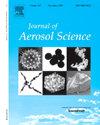Size resolution and capillary centering in sheathed condensation particle counters studied with a new variable saturation condensation particle sizer
IF 2.9
3区 环境科学与生态学
Q2 ENGINEERING, CHEMICAL
引用次数: 0
Abstract
The variable-saturation condensation particle sizer (VSCPS) of Gallar et al. (2006) determines aerosol condensation (Kelvin) size distributions by measuring optically the concentration of grown particles, while quickly scanning over the saturation ratio. A time-varying yet spatially uniform saturation is achieved by injecting the aerosol with a capillary placed at the center of a larger flow of sheath gas, created by mixing variable proportions of a saturated and a dry flow. Prior studies with other VS CPSs with centered capillary injectors had shown excellent sizing resolution when scanning over the saturator or the condenser temperature. However, some VSCPSs exhibited poorer resolution. Using the VSCPS of Gallar et al. (2006) we observe here that a chief reason for resolution variability is an imperfect capillary centering. A new VSCPS design preserving an excellent centering upon assembling and disassembling is then tested, systematically achieving excellent resolution. We also widen the cross sections of the aerosol and the sheath flow at their merging region to reduce the corresponding Reynolds numbers, and hopefully maintain laminar flow at larger aerosol and sheath gas flow rates. This goal is also largely achieved, except at small aerosol flows, though at the cost of an increased response time.
用一种新型可变饱和缩聚粒度仪研究了套套式缩聚颗粒计数器的尺寸分辨率和毛细管定心
Gallar等人(2006)的可变饱和凝结粒径仪(VSCPS)通过光学测量生长颗粒的浓度来确定气溶胶凝结(开尔文)尺寸分布,同时快速扫描饱和比。一种时变但空间均匀的饱和是通过在较大的鞘层气体流中心注入毛细管来实现的,这种气体流是由饱和流和干流的可变比例混合而成的。先前的研究表明,在饱和器或冷凝器温度下扫描时,其他带有中心毛细管进样器的VS cps具有出色的尺寸分辨率。然而,一些vscps表现出较差的分辨率。使用Gallar等人(2006)的VSCPS,我们在这里观察到分辨率变化的主要原因是毛细管中心不完善。然后测试了一种新的VSCPS设计,在组装和拆卸时保持了良好的中心,系统地实现了出色的分辨率。我们还扩大了气溶胶和鞘层流在合并区域的横截面,以降低相应的雷诺数,并希望在较大的气溶胶和鞘层气体流速下保持层流。这一目标也在很大程度上实现了,除了在小的气溶胶流动中,尽管代价是增加了响应时间。
本文章由计算机程序翻译,如有差异,请以英文原文为准。
求助全文
约1分钟内获得全文
求助全文
来源期刊

Journal of Aerosol Science
环境科学-工程:化工
CiteScore
8.80
自引率
8.90%
发文量
127
审稿时长
35 days
期刊介绍:
Founded in 1970, the Journal of Aerosol Science considers itself the prime vehicle for the publication of original work as well as reviews related to fundamental and applied aerosol research, as well as aerosol instrumentation. Its content is directed at scientists working in engineering disciplines, as well as physics, chemistry, and environmental sciences.
The editors welcome submissions of papers describing recent experimental, numerical, and theoretical research related to the following topics:
1. Fundamental Aerosol Science.
2. Applied Aerosol Science.
3. Instrumentation & Measurement Methods.
 求助内容:
求助内容: 应助结果提醒方式:
应助结果提醒方式:


